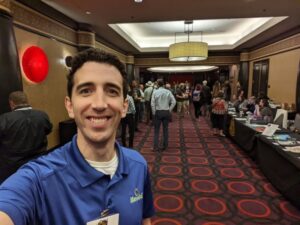For 65 years, geologists, engineers, students, and other professionals from around the country have gathered for a week of technical sessions, field courses, and networking at the Association of Environmental & Engineering Geologists (AEG) Annual Meeting.
This year in Las Vegas, Luke Johnstone, Project Environmental Engineer at Mundell & Associates, presented Mundell’s work on surface-aquifer interactions at a regional levee system during the Dams and Levees Symposium.
The project focused on using advanced monitoring and modeling techniques of surface-aquifer interactions to determine implications on infrastructure design at a levee system near the Ohio River.
The levee sponsor needed to determine the potential impact, if any, that local groundwater seepage forces due to Ohio River flood events may have on a proposed channel designed to convey regional surface water. The project used a multi-phase seepage evaluation of the levee system to calibrate advanced hydrogeologic models of surface water and aquifer interactions in areas extending beyond the levee. Often the design of stormwater infrastructure hinges only on models focused on the rainfall, runoff, and routing of stormwater through a system in the immediately vicinity.
Geotechnical and geophysical investigations with an extensive monitoring network supplied data that was incorporated into an evaluation of the proposed drainage design. Would there be potential failure pathways due to heaving, piping or unaccounted for seepage flows?
The study concluded that the channel design did not adequately account for seepage forces and described potential implications along with recommending additional design considerations.
Additionally, this work highlights the need for better collaboration between geological and water resource professionals. Identifying situations when surficial drainage design must include seepage interactions can be challenging for water resource engineers who may lack the awareness, experience, or expertise to properly consider or characterize advanced hydrogeologic conditions – particularly in areas where stream-aquifer interactions are critical but may not be readily apparent.
The conference was also a chance to network with individuals who are doing incredible work to advance dam and levee safety around the country & world. It was a packed agenda, but Luke took the time to visit one of the country’s most famous dams – the Hoover Dam!
Co-authors of this project included Mundell & Associates colleagues John Mundell, Tyler Balson and Forrest Kunkel.


